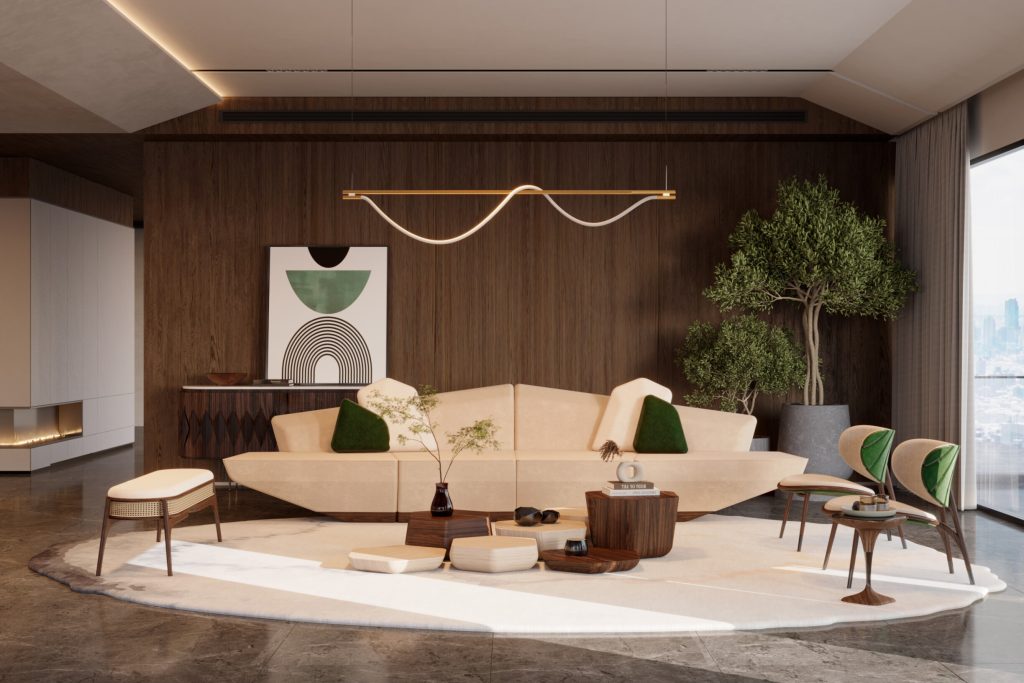Sustainability refers to maintaining something for a long time without causing harm to nature or environmental components to protect future generations. This is about balancing the present and future needs at the same time. In other words, using the natural resources such as water, energy and raw materials responsibly so that we and our future generation would not face any difficulties. Sustainability mainly maintains three things such as environmental, social, and economic. Its primary goal is to reduce the negative impact on these three components. So, sustainability in interior design is crucial since it reduces the negative influence on the environment and one’s physical health, as human health is inextricably linked to the environment. Furthermore, sustainable interior design enhances product longevity, making this a valuable long-term investment.
What is sustainability in interior design?
In interior design, sustainability is crucial in various aspects, as it protects both human’s health and environment. Lets explore the importance of sustainability in interior design.
Environmental protection: Sustainability helps to minimize the waste, lower energy consumption to protect the environment for the future generations. This contributes to mitigating climate change and saves the natural resources to balance the present and future needs and environment as well.
Health and well- being: Human’s mental and physical health is deeply connected to the nature, so protecting the nature is the another way of protecting ourselves. The sustainable materials like low-voc, natural febrics improves the air quality in indoor spaces. Moreover, Biophilic design principles, which is natural resources, helps to reduce stress.
Economical viability: Sustainable materials can be more expensive initially, but they frequently save money over time by being more durable, using less energy, and requiring less upkeep.
Social responsibility: A more egalitarian and socially conscious strategy to design strategy can be achieved through sustainable design, which can also incorporate fair hiring practices and appropriate sourcing of materials.
Longevity and durability: Durable, long-lasting materials and building techniques are frequently given priority in sustainable design, which minimises waste and eliminates the requirement for frequent replacements.
Reduce environmental impact: Sustainable interior design seeks to reduce a space’s total environmental impact by thoroughly investigating the lifecycle of materials, from procurement to disposal.
How to implement sustainability in interior design?
Implementing sustainability in interior design involves a number of steps, including selecting sustainable materials and keeping an eye on factors like indoor air quality, waste reduction and durability, and energy efficiency.
Choosing sustainable materials in interior design
Choosing sustainable materials in interior design is crucial as this is the primary step. There are several sustainable materials which is good for the environment and people as well.
Bamboo: Bamboo is a quickly renewable resource that is robust, resilient, and adaptable, making it appropriate for wall wrappings, carpeting, and equipment.
Cork: Cork is a natural resource that is harvested from the bark of cork oak trees and is prized for its distinctive texture, insulating qualities, and ability to absorb sound.
Reclaimed wood: In furtherance of reducing deforestation, using wood from historic buildings or constructions gives your room a distinctive look.
Natural stone: Marble and granite are strong, long-lasting materials that can be sourced ethically.
Rattan and cane: For furniture and decor, these natural fibres provide a sustainable substitute.
Sustainable interior design is more than just a trend; it’s a moral obligation that designers can address. Designers promote beauty while using sustainable practices and materials to create spaces with positive environmental, social and economic impacts. Designers can advocate for action by choosing renewable materials (e.g. bamboo, cork, rattan, textiles and wood materials that are sustainably harvested), emphasizing energy as a resource (e.g. using less with efficient lighting, appliances, or heating/cooling systems), highlighting indoor air quality and promoting a healthier planet along with a better quality of life. To this end, as the world becomes more focused on living consciously, it is paramount to adopt sustainable practices as not only the future, but also the need of the moment and the relevance to interior design in a sustainable way. In this context, a few institutes provide interior design courses in Kolkata, including sustainable interior design. NIF Global Saltlake is one of the leading interior design institutes in Kolkata, providing a thorough approach to interior design, including sustainable design.




